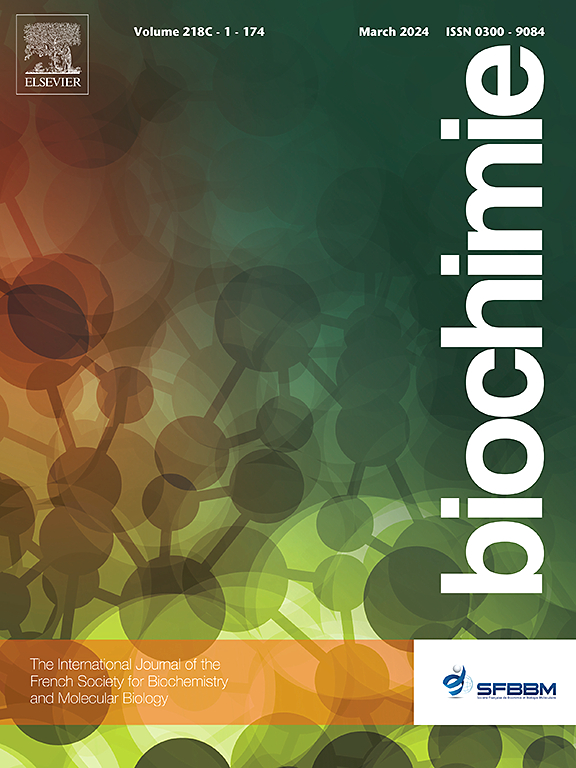Divergent ferroptotic pathways in breast cancer cells: IGFBP6-regulated mitochondrial lipid peroxidation under erastin and omega-3 DHA treatment
IF 3
3区 生物学
Q2 BIOCHEMISTRY & MOLECULAR BIOLOGY
引用次数: 0
Abstract
Breast cancer remains a major challenge and new therapeutic approaches are needed for its treatment. Ferroptosis is considered a promising alternative cell death mechanism to eliminate resistant cancer cells. In previous works, we identified that lower IGFBP6 gene expression in tumor tissue corresponds to a worse prognosis for breast cancer patients and, at the same, time makes them more sensitive to ferroptosis. In this study, we further investigated the mechanism of ferroptosis induction in IGFBP6 knockdown and control MDA-MB-231 breast cancer cells by the canonical ferroptosis inducer erastin and omega-3 docosahexaenoic acid (DHA). Our results indicate that there is a significant overlap between the mechanisms of action of both of these molecules, as they regulate the same subset of genes, and their action can be inhibited by canonical ferroptosis inhibitors. On the other hand, we also observed significant differences between the effects of erastin and DHA. The most notable of these are the additional activation of apoptosis-related genes by DHA and its minor peroxidation of mitochondrial lipid membranes. Interestingly, our kinetic analysis of ferroptosis induction showed that IGFBP6 knockdown cells began to die earlier and could hardly be rescued from erastin-induced ferroptosis by mitochondrial antioxidant SkQ1, in contrast to control cells. Overall, our data suggest that the action of DHA is less dependent on mitochondrial membrane peroxidation during ferroptosis induction, and this molecule can be a promising candidate for the treatment of breast cancer, especially in the case of reduced IGFBP6 gene expression in cancer cells.
乳腺癌细胞中不同的铁细胞凋亡途径:igfbp6在erastin和omega-3 DHA处理下调节线粒体脂质过氧化。
乳腺癌仍然是一项重大挑战,需要新的治疗方法来治疗。铁突变被认为是一种很有前景的替代细胞死亡机制,可以消灭耐药的癌细胞。在之前的研究中,我们发现肿瘤组织中 IGFBP6 基因表达较低会导致乳腺癌患者预后较差,同时也会使其对铁蛋白沉降更为敏感。在本研究中,我们进一步研究了IGFBP6基因敲除和对照组MDA-MB-231乳腺癌细胞在经典铁变态反应诱导剂依拉斯汀和ω-3二十二碳六烯酸(DHA)诱导下的铁变态反应机制。我们的研究结果表明,这两种分子的作用机制有很大的重叠,因为它们调控相同的基因子集,而且它们的作用可以被典型的铁突变抑制剂抑制。另一方面,我们也观察到麦拉宁和 DHA 的作用存在显著差异。其中最明显的是 DHA 对凋亡相关基因的额外激活及其对线粒体脂膜的轻微过氧化作用。有趣的是,我们对铁凋亡诱导的动力学分析表明,与对照细胞相比,IGFBP6 基因敲除的细胞开始死亡的时间更早,而且很难被线粒体抗氧化剂 SkQ1 从麦拉宁诱导的铁凋亡中解救出来。总之,我们的数据表明,在诱导铁变态反应的过程中,DHA的作用对线粒体膜过氧化的依赖性较低,这种分子可能是治疗乳腺癌的一种有前途的候选药物,尤其是在癌细胞中IGFBP6基因表达减少的情况下。
本文章由计算机程序翻译,如有差异,请以英文原文为准。
求助全文
约1分钟内获得全文
求助全文
来源期刊

Biochimie
生物-生化与分子生物学
CiteScore
7.20
自引率
2.60%
发文量
219
审稿时长
40 days
期刊介绍:
Biochimie publishes original research articles, short communications, review articles, graphical reviews, mini-reviews, and hypotheses in the broad areas of biology, including biochemistry, enzymology, molecular and cell biology, metabolic regulation, genetics, immunology, microbiology, structural biology, genomics, proteomics, and molecular mechanisms of disease. Biochimie publishes exclusively in English.
Articles are subject to peer review, and must satisfy the requirements of originality, high scientific integrity and general interest to a broad range of readers. Submissions that are judged to be of sound scientific and technical quality but do not fully satisfy the requirements for publication in Biochimie may benefit from a transfer service to a more suitable journal within the same subject area.
 求助内容:
求助内容: 应助结果提醒方式:
应助结果提醒方式:


